cinnamon raisin sourdough bread

For fans of cinnamon raisin bread or sourdough bread, this Cinnamon Raisin Sourdough Bread is the perfect marriage of two beloved recipes! Sweet with spices and studded with raisins, every bite of this sourdough loaf is full of wholesome, heartwarming flavor. Top a toasted slice with butter and a sprinkle of sea salt for a *chef’s kiss* seriously perfect breakfast or snack.
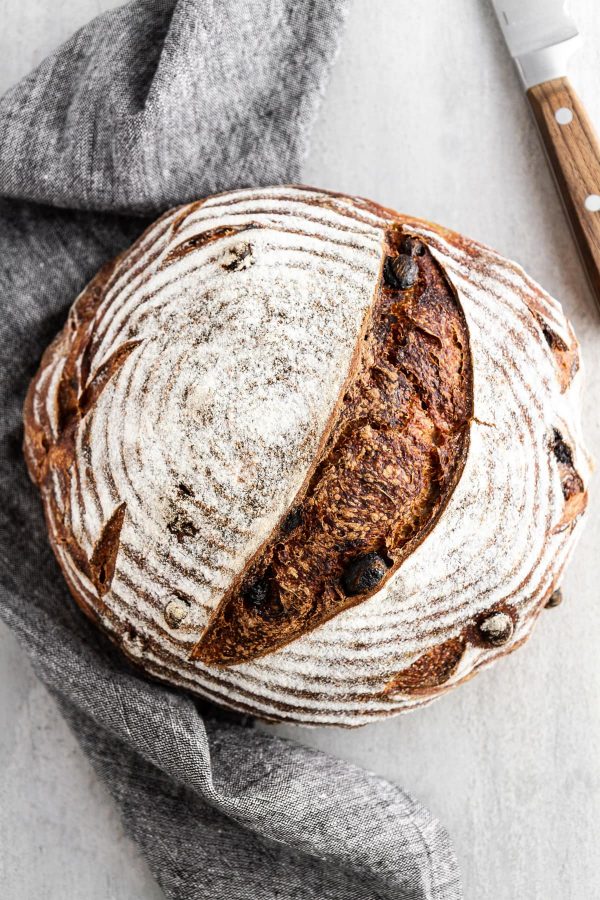
Cinnamon Raisin Sourdough Bread
OK hi, hello, I made you some bread. But not just any bread — my favorite sourdough bread, elevated with cinnamon and raisins! I’ve been wanting to bake up this variation on sourdough bread for a literal age, and now that we are here, I couldn’t be happier. Once you give it a try, you’ll feel the joy, too.
This cinnamon-spiced, raisin-studded sourdough loaf is a variation of my Favorite Sourdough Bread Recipe, with just a few tweaks — including the addition of cinnamon and raisins (duh) plus a change in the bake temperature and time. These updates are not interchangeable between the original recipe and this one — in testing this recipe, these updates are what work best for this particular variation. Just so ya know! I never want to lead you astray when it comes to our dear ole friend, Sourdough.
Ingredients for the Best Cinnamon Raisin Sourdough Bread
The best sourdough bread starts with the best ingredients, and the best cinnamon raisin sourdough bread ALSO starts with the best ingredients. What a coincidence! Here’s what you’ll need to get this delicious loaf of goodness in your life:
- A mature sourdough starter (here’s a complete how-to guide to make your own starter!)
- Whole wheat flour
- Distilled water (or filtered tap water), at room temperature
- Bread flour
- Raisins
- Cinnamon
- White rice flour for dusting and shaping (highly recommend using white rice flour for dusting and shaping, as it preserves the hydration of the bread because it doesn’t absorb as easily, and it gives the bread a pretty “dusted” look once baked)
If you’re new to sourdough, you’ll also need several essential tools for sourdough baking!
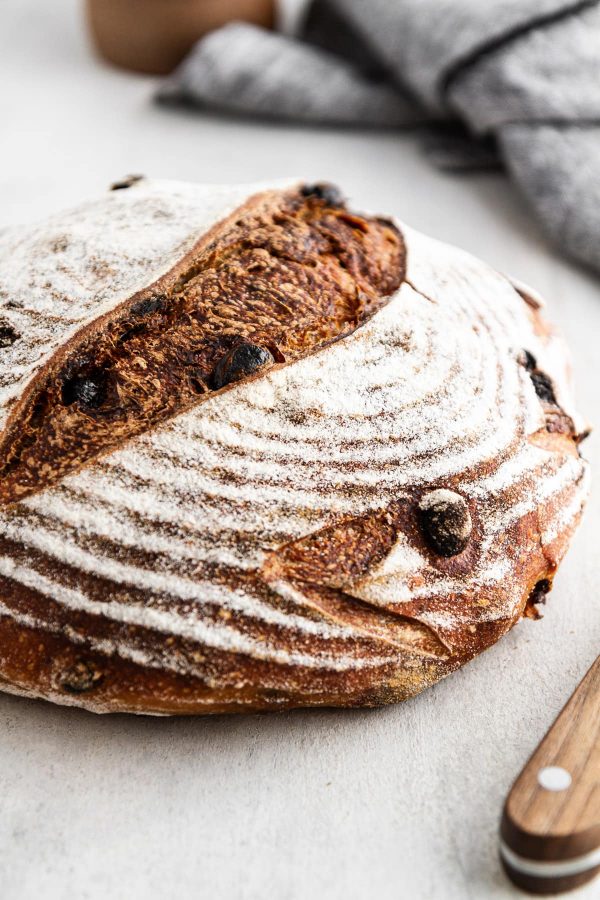
How to Make Cinnamon Raisin Sourdough Bread
The process to make this flavored sourdough bread is very similar to my original recipe, so I highly recommend getting yourself acquainted with the classic recipe first so you understand the fundamentals of sourdough (like “bulk fermentation,” how to shape a sourdough boule, how to score your loaves, etc.). If you’ve been baking sourdough for a while now, here’s how to make this sweetly spiced variation:
- Step 1: Make your levain.
- Step 2: The next day, mix your levain with more flour and water. Also, soak the raisins so they rehydrate and stay plump in the sourdough bread.
- Step 3: Add the raisins and cinnamon to the dough along with some salt and water. Mix it all up.
- Step 4: Bulk fermentation time! Perform six sets of turns every 30 minutes to strengthen the dough and let it rise.
- Step 5: Preshape the dough into two rounds, and let them rest.
- Step 6: Shape each dough round into a boule, place in their prepared bannetons or bowls, and proof in the fridge overnight.
- Step 7: The next morning, heat your oven with the combo cooker or Dutch oven inside.
- Step 8: Place the dough round on a sheet of parchment, score as desired, and transfer to the preheated combo cooker.
- Step 9: Bake the first loaf until deeply browned.
- Step 10: Repeat with the second loaf, and let both loaves cool completely.
This bread is indeed a labor of love, but you will be rewarded with a kitchen that smells like sweet spices and fresh bread and happiness and sunshine and rainbows and unicorns. And you’ll have fresh bread to eat, too. What could be better?
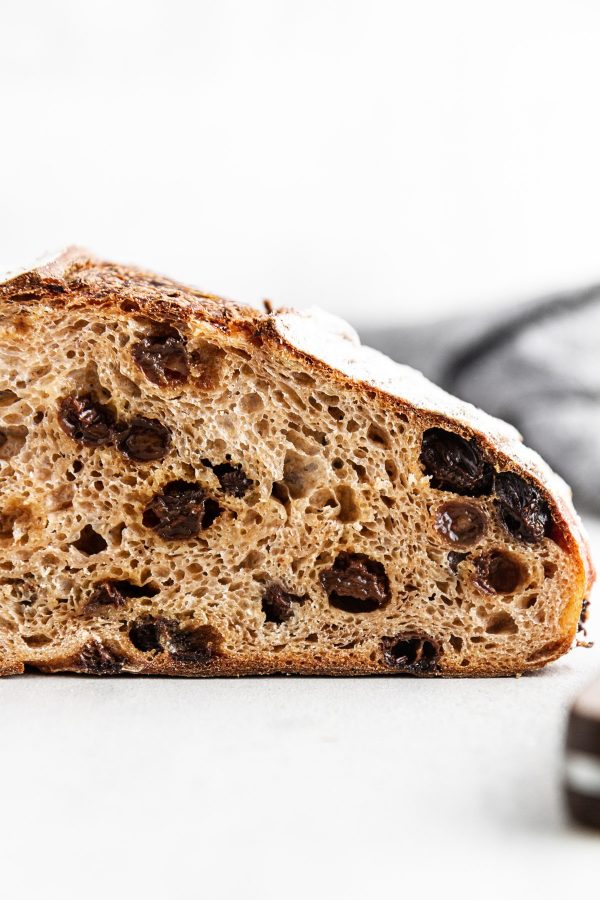
Tips for the Best Cinnamon Raisin Bread
I know you’re just itching to make this bread now, but let’s cover a few important tips before you run off to the kitchen:
- Do not skip the step of soaking the raisins. You’ll want them to be nice and plump and hydrated so that, when you go to bake the bread, they stay moist and sweet instead of dry and sour.
- Be sure to mix the raisins and cinnamon into the dough as much as possible. If you end up with a clump of raisins in the dough, it is fine — they’ll disperse as you go through the turns in the bulk fermentation stage.
- Some people have said that cinnamon inhibits the dough from rising during bulk fermentation, but I have not had this experience. If you get to the end of the bulk fermentation and your bread isn’t as risen as you’d like, let it rise an extra 30 minutes to 1 hour, tops.
- I 100% recommend serving this bread sliced and toasted with butter and a sprinkle of sea salt. It’ll change your life.
Here’s to our shared love of cinnamon raisin bread and sourdough bread coming together for a lifetime of joy and carb-filled happiness. Happy baking! I also love this Classic Banana Bread!
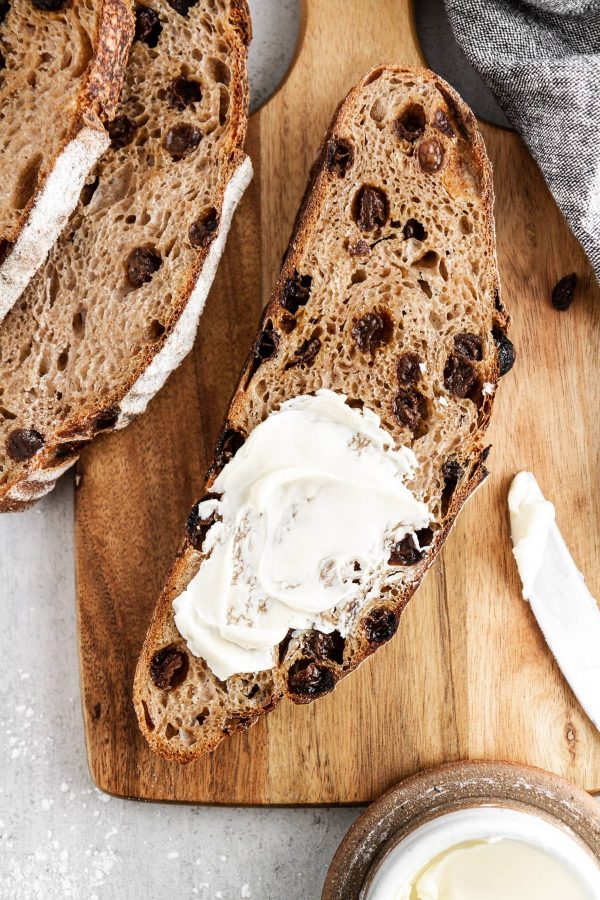
More Delicious Bread Recipes
- rosemary-garlic no-knead bread
- no knead ciabatta bread
- classic brioche loaf bread
- classic italian bread
- whole wheat bread
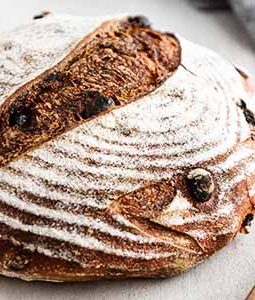
Cinnamon Raisin Sourdough Bread
- Prep Time: 36 hours
- Cook Time: 1 hour 30 minutes
- Total Time: 37 hours 30 minutes
- Yield: 2 loaves 1x
- Category: Bread
- Method: Bake
- Cuisine: American
Description
This cinnamon-spiced homemade sourdough bread is speckled with raisins for a sweet twist on my favorite sourdough bread recipe! Enjoy toasted and warm with butter for breakfast or as a snack and prepare for full-on bread bliss.
Ingredients
For the levain:
- 50g mature starter
- 200g whole wheat flour
- 200g distilled water
For the dough mix:
- 250g levain
- 800g distilled water, divided
- 800g bread flour
- 200g whole wheat flour
- 250g raisins
- 20g fine sea salt
- 16g ground cinnamon
For the preshape:
- Bread flour or all-purpose flour, for shaping
For the shape:
- White rice flour, for dusting the baskets/linen-lined bowls
Instructions
- (NOTE: Times are a suggestion. Please adjust as desired according to your schedule.) At 9:15 p.m. PREPARE LEVAIN: Place a clean starter jar on a kitchen scale. Tare the weight so it reads “0”, then to the jar add 50g mature starter, 200g whole wheat flour and 200g distilled water at room temperature. Stir the mixture vigorously until no dry bits of flour remain, then cover the jar loosely with a lid. Store in a warm place (such as the oven with the light on) for approximately 10-12 hours.
- At 8:30 a.m. (next day) PREPARE AUTOLYSE: The next morning, place a medium to large mixing bowl on a kitchen scale. Tare the weight so it reads “0”, then to the bowl add 250g levain and 750g distilled water at room temperature. Stir the mixture until the levain is completely dissolved. Add 800g bread flour and 200g whole wheat flour. Mix with your hands until mixture is completely incorporated. Cover bowl with plastic wrap and place in a warm place (such as the oven with the light on) for 50 minutes. Meanwhile, in a separate medium bowl, soak raisins in room temperature water for 30 minutes to hydrate; drain and pat dry.
- At 9:20 a.m. FINISH THE DOUGH MIX: To the mixing bowl add 20g fine sea salt and remaining 50g distilled water (at temperature calculated as described in this post to achieve final dough temperature of 78°F). Add raisins and cinnamon, as well. Mix with your hands until mixture is completely incorporated. Cover bowl with plastic wrap and place in a warm place (such as the oven with the light on) for 30 minutes.
- At 10 a.m. BULK FERMENTATION: After 30 minutes have elapsed, perform the first set of turns (see this post for full description on how to perform a set of turns). Cover the bowl and return it to its warm place.
- At 10:30 a.m. Perform second set of turns. Cover and return to warm place.
- At 11 a.m. Perform third set of turns. Cover and return to warm place.
- At 11:30 a.m. Perform fourth set of turns. Cover and return to warm place.
- At 12 p.m. Perform fifth set of turns. Cover and return to warm place.
- At 12:30 p.m. Perform sixth and final set of turns. Cover and return to warm place to finish bulk fermentation, untouched.
- At 2:00 p.m. PRESHAPE: Gently transfer dough to a well-floured surface. Using a well-floured bench scraper or knife, divide dough into two equal pieces. Use floured hands to gently but quickly shape each piece of dough into a tight round (see this post for full description on preshape). Cover dough with bowls and let rest on counter for 30 minutes.
- At 2:30 p.m. SHAPE AND PROOF: Lightly dampen and dust two banneton baskets or linen-lined bowls with white rice flour. Remove bowls from dough. Shape dough into boule (see this post for full description on how to shape into a boule). Carefully transfer dough to one prepared basket. Repeat with second dough.
- Cover each basket with a plastic bag; use a clip to seal bag. Let dough rest in bags at room temperature 20 minutes, then transfer to refrigerator for an overnight proof.
- At 7:30 a.m. (next day) PREHEAT: Place an oven rack on bottom third of oven. Place deep side of combo cooker facing down on one side of oven rack; place shallow side of combo cooker facing up on other side. Preheat oven to 500°F for 1 hour.
- Just before baking, remove one dough from refrigerator and plastic bag. Place a sheet of parchment paper and a cutting board on top of basket. Carefully invert basket with cutting board so dough lands on parchment paper. Remove basket. Use a bread lame to score top of dough.
- At 8:30 a.m. BAKE: Using oven mitts, carefully slide dough on parchment paper to shallow side of combo cooker. Place deep side of combo cooker on top to seal. Reduce oven temperature to 450°F. Bake covered 25 minutes. Using oven mitts, remove top of combo cooker and return to oven rack in oven to keep hot. Bake bread uncovered another 20-25 minutes until a deep golden brown (an instant thermometer should read an internal temperature of approximately 210°F). Transfer bread to a cooling rack to cool completely, about 1 hour 30 minutes. Repeat with second loaf.
Notes
- For step-by-step photos, printable schedules and plenty of tips, please head to my Sourdough 101 series for full details.
- NOTE: This recipe differs from my Favorite Sourdough Bread Recipe in terms of temperatures and bake time — PLEASE read through the recipe before you plan to make it!
- Store leftover bread cut side-down on a cutting board uncovered at room temperature up to 1 day; after that, store in a bread box or resealable plastic bag at room temperature for another 1-2 days.
- If you want to freeze your sourdough: Cool the loaf completely, then place in a resealable plastic bag. Freeze for up 2 months. Thaw bread overnight in its bag at room temperature.
- For best results, use exactly the types/amounts of flours indicated in the recipe. I cannot guarantee similar results with any substitutions.

Can this be made with a bread recipe that is not sourdough?
Thank you!
Catherine, You could try half the amount of raisins and cinnamon in this recipe for my No-Knead Dutch Oven Bread, though I can’t guarantee similar results.
This looks yummy! Can you freeze the dough before baking? I don’t think we will eat two loaves at once.
Danielle, I’d recommend freezing the bread after baking! Let the loaf cool completely, then store it in the freezer in a resealable bag for up to 2-3 months. Thaw the bread in the bag on your countertop overnight and it’s good to go!
Hi. Getting my starter ready to make this incredible looking bread. Would like to know if I can add toasted walnuts, how much and when to add. Rustic walnut raisin bread is my all-time fav!!!
Rose, Yes you can add walnuts! I’d add about 1 cup for 2 loaves, and add them in when you add in the raisins and cinnamon. Yum!
I made this and added the 1 cup of toasted walnuts with the raisins, and oh my, it is heavenly, not to mention absolutely gorgeous! It’s sweet, tangy and crunchy all in one bite :). And adding a touch of coarse salt to the butter is the best.
Definitely a labor of love, but not difficult, and worth every minute. Thanks for a wonderful recipe.
Rose
This was amazing!! I’ve used your “My Favorite Sourdough” recipe several times with great results. However, I recently changed my bread flour and found that my dough was far too slack when shaping, so I lowered the hydration by just 5% for this recipe. I found that it did really well, but I think I could probably add in more water next time.
This bread + a little bit of peanut butter is my new go-to breakfast! Thanks for sharing!
Lindsey, Oh I’m so glad! So impressed by your skills to adjust the dough as needed. 🙂 Happy peanut butter toasting!
This bread was so delicious! I only had golden raisins on hand but they worked just fine and tasted great. Thank you, Stephanie, for laying out the baking process in digestible and approachable steps. I can’t wait to make this over and over again.
Rebecca, Oh I’m so glad! Thank you so much!
I love your recipe! I’m trying to figure out how to change the schedule so that I can do bulk fermentation in the afternoon. If I made the levain at 7 am, do you think it would be ready to start mixing the dough at 3 pm?
Love this recipe! I want to adjust the time to do bulk fermentation in the evening. Do you think if I start the levain at 7 am it would be ready to mix the dough by 3 pm?
Kayla, I always recommend letting the levain sit/rise for at least 10-12 hours!
Love this recipe. Made the bread twice now and it turns out perfect. I have also experimented with a different flour combination, 400 g whole wheat and 400 g einkorn and 200 white. Turned out amazing.
Dear Stephanie,
Many-many thanks for this gorgeous recipe! I’ve made it this morning, tried a bit … it’s mind-blowing. The best wheat sourdough bread I’ve ever had. Your focaccia is the next on the list :)))
Marie, Thank you so so much! I’m so glad you love it as much as we do.
Hey! I just wanted to ask if you’ve tried baking this with the second prove at room temp (say 3 hours or so depending on how warm it is),
As opposed to an overnight prove in the fridge? Or dose the overnight prove benefit the overall end loaf? Thanks! Excited to try 🙂
Thanks for this wonderful recipe; turned out amazing. I shared it, of course, and received many yummy
compliments. I hesitated adding so much cinnamon but the result is not overpowering. I soaked my raisins in orange juice and it added a slight taste. I’ll be making it again soon because we don’t have much left already
and I will be giving one as a gift. Your instructions are clear and easy to follow too. Thanks again…
Carol
Carol, Thank you so much!
Hi Stephanie
Thank you so much for this fantastic recipe. This is only my fourth bread and I’m very excited about the results. I used 50/50 flour mixture and soaked my raisins in orange juice.
Do you think instead of proofing overnight in the fridge we could just proof as usual and cook it the same day? What would be different?
Carol
Carol, Thank you so much for your comment and review! I have no experience with a same-day proof and I hesitate to recommend that for sourdough bread, as it behaves differently than a traditional bread recipe. My best suggestion is to take it to Google and see if anyone else has had success with a same-day proof/bake. 🙂
Hi Stephanie: I made your Cinnamon Raisin Sourdough Bread again today, twice monthly if I don’t give any away, which is rare! I love to share it that way I get to make it more often ?. It is our favourite. Today I had never seen my levain so active, so much so that when I put my loaves in the fridge to proof overnight I hesitated. Three hours later seeing them so well risen I made the decision to cook one. Floured and slashed it and cooked it in my Dutch oven at 450 degrees for 25 minutes with cover; then removed the cover, lowered the oven to 400 degrees for an additional 25 minutes. It turned out perfect, can’t wait to taste it. Ended cooking both with excellent results. Just thought you’d like to know. I’ll be making your strawberry custard pie tomorrow….
Congrats for all your excellent recipes
Carol from Quebec, Canada
Carol, That’s so great, thank you!! I hope you enjoy the custard pie, as well. 🙂
Hi,
Quick question. Should the autolyse phase result in sticky or flaky bread? I am worried that mine is too sticky.
Thanks,
Alex
Alex, The autolyse will definitely be sticky and mostly shapeless! The bread will start to take shape and gain strength during the bulk fermentation phase. Hope that helps!
Thank you so much for getting back to me! Yes it helps loads. So excited to make this bread.
This has become my favourite. I make it every two weeks and often offer one as a special gift. Thanks so much. I would like to know if doing the final proof the same day and baking it right away would change the taste? Also, I don’t have bannetons so I final proof in parchment lined bowls making the transfer to my regular Dutch oven short and sweet. Would it improve something using the baskets?
Carol
Hi Stephanie:
I’ve made this bread many times and twice now it has not risen in the refrigerator overnight. I cooked the first one hoping it would kick up in the oven, but to no avail! Now I’m left with a dilemma for the second one.
I’m leaving it on the counter to see if it will rise more at room temperature. Any suggestions…
It is our favourite!